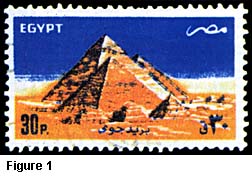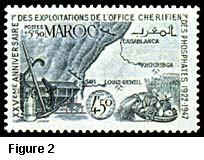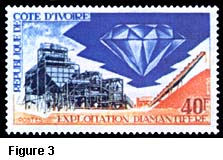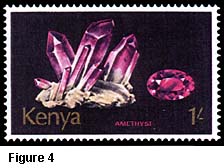by Fathi Habashi
Department of Mining and Metalhurgical, and Materials Engineering
Laval University, Quebec City
as published in the January-February 2001 issue of The Canadian Philatelist.
Introduction
Industrial minerals are usually divided into three groups:
* Abundant. These are abundant in all geologic environments, used in large amounts, and are relatively cheap. For example, limestone, clay, sand, gravel, and stones.
* Widely available. These occur in large quantities in few geologic environments, are used in appreciable amounts, and command a moderate price. For example, asbestos, coal, phosphate, gypsum, kaolin, potash, salt, sulfur, talc, trona, barite, borates, feldspar, fluorite, magnesite, and diatomite.
* Rare. These occur in small quantities, in limited areas, used in small quantities, and command a high price. For example, diamonds, sheet mica, graphite, corundum, the precious stones, and the semi-precious stones.
Strictly speaking, some of the members of these groups are not minerals but ores having a geological name. For example, phosphate rock is neither a rock nor a mineral; it is a geologic name for a certain type of formation containing phosphate minerals associated with gangue minerals such as calcite, iron oxides, clays, etc. The major phosphate mineral of economic value in this type of deposit is apatite which is principally calcium phosphate. A book recently published in Canada portrays the mining and metallurgy sectors as shown on postage stamps. The stamps replicas all in colour and are enlarged for clarity. A sample of those devoted to industrial minerals are shown [here].
Abundant industrial minerals
 Limestone, or calcium carbonate, is one of the most abundant industrial minerals. The largest
construction made of limestone is the Khufou pyramid of Egypt (Figure 1) [Scott #C182].
Thousands of miners and masons must have worked for a number of years to build such a monument.
Calcination of limestone to produce lime (calcium oxide) has been used in mortar since ancient
times. A stamp from Aden [Scott #49] shows a worker breaking limestone and in the background
a lime kiln. The stamp issued in 1963, i.e., before independence from Britain shows the
local Sultan on the top corner, and is entitled "Lime Burning." In exact terminology, it
should have been entitled "Calcination of Limestone" or "Lime Production."
Limestone, or calcium carbonate, is one of the most abundant industrial minerals. The largest
construction made of limestone is the Khufou pyramid of Egypt (Figure 1) [Scott #C182].
Thousands of miners and masons must have worked for a number of years to build such a monument.
Calcination of limestone to produce lime (calcium oxide) has been used in mortar since ancient
times. A stamp from Aden [Scott #49] shows a worker breaking limestone and in the background
a lime kiln. The stamp issued in 1963, i.e., before independence from Britain shows the
local Sultan on the top corner, and is entitled "Lime Burning." In exact terminology, it
should have been entitled "Calcination of Limestone" or "Lime Production."
Clays are another type of abundant industrial minerals. They are hydrated aluminum silicates. Together with limestone they are used in the manufacture of cement. The raw materials are heated at high temperature in slowly rotating and slightly inclined furnaces known as kilns. A large cement kiln is shown on a Russian stamp [Scott #2355].
Coal is the most dangerous industrial mineral to mine because of the presence of explosive and combustible hydrocarbon gases in the mines. Many countries have recognized its importance for the economy and stamps were issued honouring this industry. For example, Australia commemorated 200 years coal mining in that country by issuing a stamp in 1947 [Scott #209]. The stamp shows machines handling coal for coke-making plant.
Widely available industrial minerals
Salt or sodium chloride is the most ancient industrial mineral, it was already recovered from sea water and from underground mines by the ancient peoples. Many ancient trade routes have been due to salt localities or salt springs and battles have been fought for their possession. Salt has at times served for currency, and during many centuries in many countries has served as a salary. The word salary comes from Latin for salt
Sodium chloride has a cubic structure and it was the first to be examined by x-ray diffraction method. As a result it was concluded that the crystal is composed of an array of positively charged sodium ions and negatively charged chloride ions held together by electrostatic forces. A stamp issued by the United Kingdom in 1977 on the occasion of the 100th anniversary of The Royal institute of Chemistry illustrates this pattern [Scott #809]. The stamp also honours William Henry Bragg (1862-1942) and his son
William Lawrence Bragg (1890-1971) who shared the Nobel Prize for physics in 1915 for their work elucidating NaCl structure. Bragg senior was president of The Royal Institute of Chemistry from 1935 to 1940.
When sodium chloride occurs in underground mines it is known as the mineral halite. The cubic crystals of halite are shown on few stamps, for example, from the former German Democratic Republic [Scott #1358], Poland, and the Republic of Equatorial Guinea.
 North and Central African countries are large producers of phosphate rock. Morocco in 1947,
issued a stamp marking the 25th anniversary of the foundation of the industry; the stamp shows
the location of the two mines at Khouribga and Louis Gentil, the port of Safi, and Casablanca
where the administration is located (Figure 2) [Scott #B334]. The importance of phosphate for
agriculture is indicated by fruits and wheat at the lower right corner of the stamp. The
phosphate industry in Morocco is a nationalized industry controlled by the Office Cherifien
da Phosphate.
North and Central African countries are large producers of phosphate rock. Morocco in 1947,
issued a stamp marking the 25th anniversary of the foundation of the industry; the stamp shows
the location of the two mines at Khouribga and Louis Gentil, the port of Safi, and Casablanca
where the administration is located (Figure 2) [Scott #B334]. The importance of phosphate for
agriculture is indicated by fruits and wheat at the lower right corner of the stamp. The
phosphate industry in Morocco is a nationalized industry controlled by the Office Cherifien
da Phosphate.
Common crystals of gypsum are shown on few stamps, e.g., from the former German Democratic Republic [Scott #1354], while rare crystals known as "Flowers of the Desert" are shown on a South West African stamp [Scott #626].
Naturally occurring sulfur was known to the ancient civilizations and is mentioned in the Old Testament. Poland is a major supplier of sulfur produced from naturally occurring deposits. A stamp commemorating the 2Oth anniversary of the Polish People's Republic in 1964 was issued showing the mining operations at the Industrial Sulfur Complex at Tarnobrzeg [Scott #1255].
Rare industrial Minerals
India had the monopoly on diamonds until 1723 when they were discovered in Brazil and in 1867 in South Africa and then Siberia. Cecil Rhodes (1853-1902) the British statesman and capitalists was shown on a South African stamp issued in 1937 in his honour [Scott #58]. Rhodes made a fortune in South Africa by monopoly of Kimberley diamond production. He was prime minister of Cape Colony from 1890 to 1896. He left a part of his fortune to public service including Rhodes Scholarships.
 The major suppliers of diamonds in Africa issued stamps emphasizing this fact, e.g., Ivory Coast
issued in 1972 a stamp showing a diamond and a diamond mine (Figure 3) [Scott #116]. Cutting diamonds
has been practiced for many decades by Jewish artisans in Amsterdam. When the State of Israel
was founded in 1948 many of these artisans moved there and Israel became another center for
this profession [Scott #C47].
The major suppliers of diamonds in Africa issued stamps emphasizing this fact, e.g., Ivory Coast
issued in 1972 a stamp showing a diamond and a diamond mine (Figure 3) [Scott #116]. Cutting diamonds
has been practiced for many decades by Jewish artisans in Amsterdam. When the State of Israel
was founded in 1948 many of these artisans moved there and Israel became another center for
this profession [Scott #C47].
The mineral zircon is the major source of the metals zirconium and hafnium; it is zirconium silicate, ZrSiO4, in which hafnium is present to the extent of 1 to 4% in isomorphous substitution. It is a fairly common mineral but fairly rare as the gemstone known as jargon or hyacinth. When transparent and colourless it can be cut to resemble diamond. It is not as hard as diamond but heavier. in 1972, Thailand issued a stamp showing naturally-occurring zircon crystals, and a gem prepared from them [Scott #626].
 Amethyst is crystalline quartz containing trace of manganese which gives it a beautiful violet
colour, and thus finds use as a gem. It is shown on stamps issued by some producing countries,
e.g., Kenya (Figure 4) [Scott #105]. Emerald, also known as aquamarine, is a pale green transparent
gemstone of the mineral beryl which is beryllium aluminum silicate. Examples of this gemstone
appear on stamps of some producing countries, e.g., Uganda [Scott #604]. Rubies and sapphires
are trans-parent varieties of corundum, A1203. Rubies are carmine red and sapphires bright
blue. These are shown on stamps from some producing countries, e.g., Thailand [Scott #624].
Amethyst is crystalline quartz containing trace of manganese which gives it a beautiful violet
colour, and thus finds use as a gem. It is shown on stamps issued by some producing countries,
e.g., Kenya (Figure 4) [Scott #105]. Emerald, also known as aquamarine, is a pale green transparent
gemstone of the mineral beryl which is beryllium aluminum silicate. Examples of this gemstone
appear on stamps of some producing countries, e.g., Uganda [Scott #604]. Rubies and sapphires
are trans-parent varieties of corundum, A1203. Rubies are carmine red and sapphires bright
blue. These are shown on stamps from some producing countries, e.g., Thailand [Scott #624].
Epilogue
Postage stamps are an important means of communication and many countries have recorded important events, honoured worthy individuals, and described interesting facts through this medium. Stamps have artistic value, they are created by artists. They are used every day, can be found everywhere, and can be a useful means for enhancing public understanding of the mineral industry.
Reference
F. Habashi, D. Hendricker, and C. Gignac, Mining and Metallurgy on Postage Stamps, Published by Metallurgie Extractive Quebec 1999, 340 pages, about 900 enlarged coloured replica. Distributed by Laval University Bookstore "Zone."
